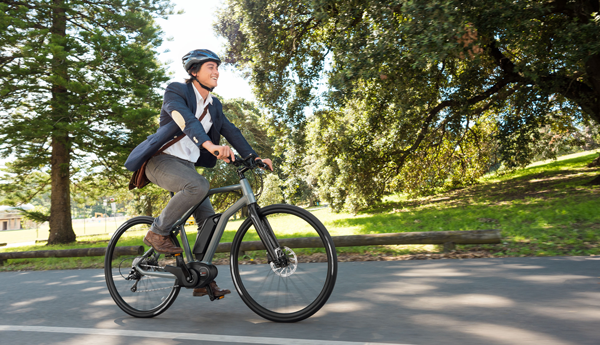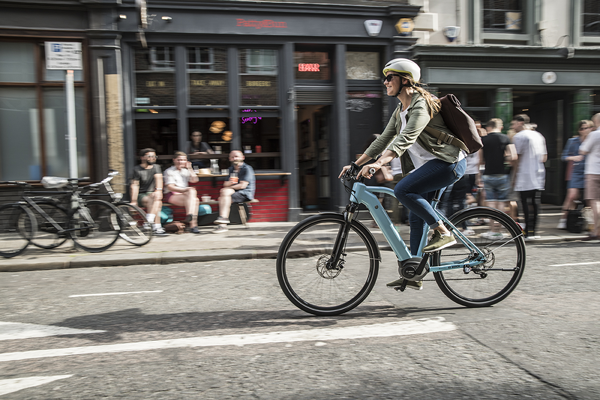Interested in purchasing an electric bike? Here are 10 things you should know!
1. Determine the level of service you want
Start with the level of service you want when your e-bike has a problem, whether it be a flat tire or the need to replace a part. If I get a flat tire on the trail, I put a patch on it, pump it up, and get on my way. I’ve seen others who, instead of carrying a patch kit with them, carry the phone number for AAA.
Additionally, you may want to visit to your local bike shop in advance to determine if they work on electric bikes, so that when a problem arises, you already know where to go. I’ve heard of several cases where someone takes his or her e-bike to the local bike store only to get turned away because that shop does not work on electric bicycles of any type. Some local shops simply don’t service e-bikes.
You might rely on a warranty; however the service level may not be what you expect. I know of one online brand with a 30-day warranty, and if you come to them with a question, they direct you to a Facebook Group of e-bike owners, meaning there is effectively no factory support at all.
You can find a name-brand bike that has local support and service; just be prepared to pay extra for the cost up front.
2. Consider your e-bike’s options for upgrades and aftermarket parts
For the e-bike you plan to purchase, how would you upgrade it later or replace its parts? Can you find parts or pieces for your bike online? Some bikes use generic or name-brand parts like Bafang or Tektro, and you can find parts and pieces for these brakes or motors online relatively easily.
Others use their own proprietary components that can’t be worked on or replaced. If you would like to hot rod your bike and make it go faster, be aware that with some bikes it is easy to do and with others it is nearly impossible.
3. How to buy an e-bike with the right amount of power
Power is probably the first thing people are going to start comparing when they look at different e-bikes. You have 250 watts, 500 watts, 750 watts, and even more combinations in between.
250 watts may not seem like much, but keep in mind that 250-300 watts is the range of power sustained by a professional cyclist, so that’s like having a pro athlete hidden in your bike pedals helping you along.
500 watts is more common in the USA. It is enough power to maintain 20 mph on flat ground and hills are easier to climb.
750 watts is the legal maximum in the United States. With 750 watts, you will be able to fly up most hills on throttle only and get up to top speed very quickly.
There are considerations beyond wattage. Some bikes will claim 750 watts, but use a smaller motor than another bike that also claims to be equal at 750 watts. Advertising claims are not always equal in real-life performance tests.
4. Choose your motor type
There are 3 main types of motors to choose from.
If you want reliability and all-around capability for riding, I would recommend the geared hub motor.
Also reliable are the direct-drive hub motors, but they tend to be heavier and are better for more powerful applications.
The mid-drive is one of my favorite set-ups and what I use on my personal bike, but the downside is that you are running all of the power through your drive train, which means more wear and tear on your chain, your derailleur, and your rear freewheel or cassette.
Read my post Which Motor Should I Choose for My Electric Bike? to learn about each type of motor in more detail.
8000-watt direct-drive hub motor
Image (above): 8000-watt direct-drive hub motor
5. Understand pedal assist and throttle
Pedal assist and throttle are two features that you need to understand. Many people ask me, “Does your bike have pedal assist or throttle?” It is generally not an either/or. In fact, I don’t know of any e-bikes on the market that do not have a pedal assist. Throttles, on the other hand, come on some bikes and not on others. Throttles are not legal in all countries (they are legal in the United States as of this writing).
You have a half-twist throttle, a thumb throttle, or even a full-twist throttle like a motorcycle. I highly recommend testing a bike that has both pedal assist and a throttle just so you can feel the difference. I find that most people prefer to own a bike with a throttle so they have the option. All of the Bolton E-bikes have pedal assist and throttle.
Half twist throttle with key
Image (above): half twist throttle with key
6. Which sensor is better?
You should know the difference between a rotation sensor and a torque sensor for your pedal assist when starting your research on how to buy an e-bike. Both have the same basic function. When you turn your cranks by pedaling, the sensors ‘sense’ the movement and they help to propel the bike forward by telling the motor to go.
Rotation sensors
The rotation sensor knows if you are pedaling and how fast, but it doesn’t know how hard you are pedaling. It is a disk with magnets around it, and there’s a sensor that mounts on the frame.
Torque sensors
Torque sensing can be found on higher-end ebikes. They are typically built into the bottom bracket, so when you are putting pressure on the crank and turning it, it doesn’t just detect that you are pedaling, but how hard you are pedaling. When you pedal with more effort, the motor helps more.
7. Choose your battery quality
The battery is an expensive component of any e-bike. You want to make sure any battery you buy has high-quality cells on the inside. All e-bike batteries use a series of 18650 cells. My preference is to stick with Panasonic, LG, or Samsung, depending on the particular bike, how much power it draws, how much range we need, and which cell best fits the application.
Of all the good lithium batteries available for e-bikes today, I would stay away from old technologies or no-name, generic brand cells.
8. Select a battery style
Electric Bike with Battery
Next, I would look at battery style. Ask yourself these questions:
1. Is it proprietary technology?
2. If, and when, my e-bike battery dies, how easy is it going to be to replace it?
If you have a generic-style battery that mounts to the frame, you can likely find the battery from another vendor or source. If you had to, you could unbolt the cradle that comes with this battery and replace it with something entirely new and no one would know the difference.
If you have a brand-name battery that does not have a generic counterpart, you may have to pay a lot more to replace that battery.
To learn more about selecting the right battery as you learn more about how to buy an e-bike, read my post Which Battery Type is Best?
9. Calculate the battery capacity
It is difficult to compare the capacity of different batteries when manufacturers make claims in different units. Some give information about amp hours, and others about watt hours. How do you compare e-bike batteries by their capacity?
Here is the formula I use:
v * ah = watt hours (voltage times amp hours equals watt hours)
Solve for the variable you need in order to get all batteries you’re comparing into the same units. If you have a watt hour rating, and they don’t give you the amp rating, but you do have the voltage, you can solve for the voltage in that formula. This way, you can accurately compare the total capacity, which is the watt hours, of any given battery.
Why does this matter? This goes to the next point.
10. Range claims don’t matter
True story: I’ve seen one bike claim 20-40 miles of range, and another bike claim 80-100 miles of range. After looking at the specifications, and using the formula to calculate the battery capacity, the batteries between the two bikes are the same. So how could one bike be claiming 20-40 miles and the other bike claim 80-100 miles?
Is it going uphill or downhill? How fast is the bike going? How much does the rider weigh? There are so many variables, that the range could be anywhere between 10 miles (full throttle, uphill, with a heavy load, killing the battery as quickly as possible) and 50 miles (if you’re riding it like a bicycle on a low pedal-assist setting and using the motor a small amount).
I tend to be conservative, so I tell people ranges that are realistic based on how the average riders uses the bike.





